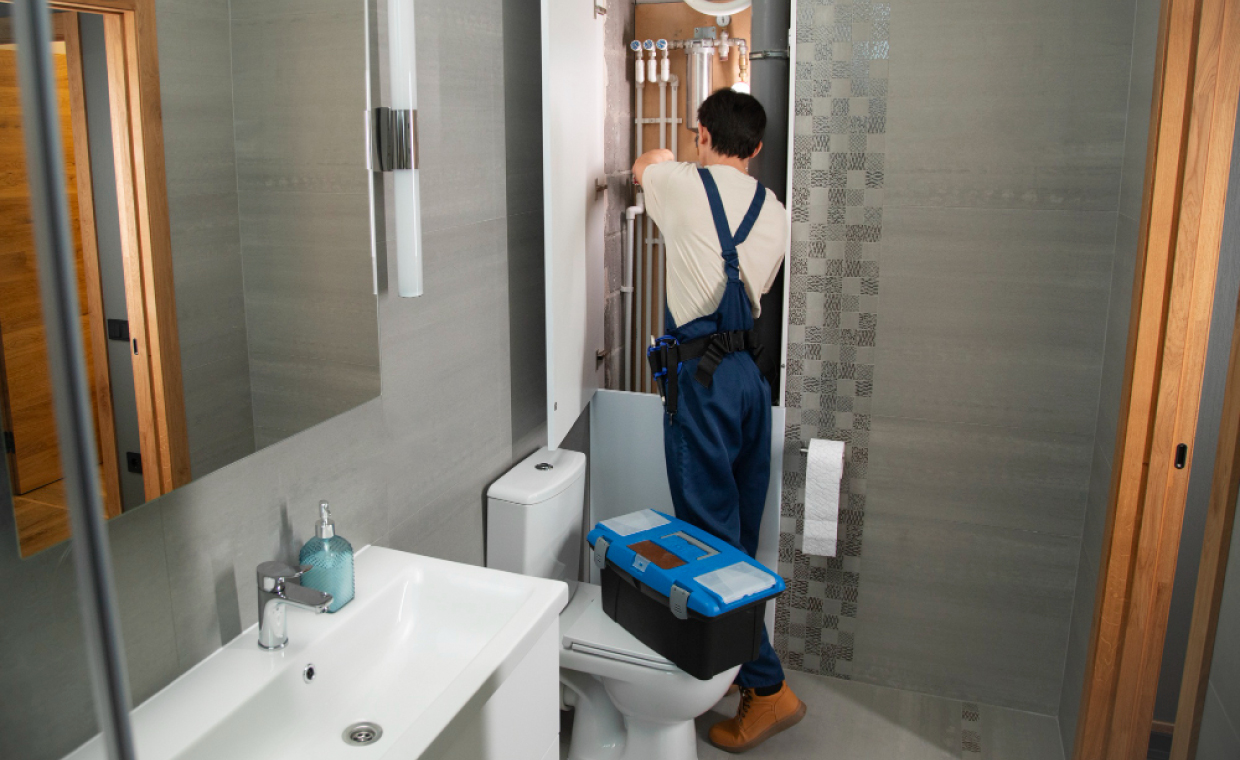
We all have a flush toilet in our home, and we’ve all wondered at one point or the other as to how it operates? Don’t worry; in this article, you’ll learn how does a toilet flush work, along with its parts and the operation of your bathroom flush tank.

A flush toilet is also called a water closet. It uses water to flush human waste from the toilet bowl to another location through a drain pipe. It can either be designed for squatting or sitting on. It is mostly linked to a sewage system, which carries waste to a composting system, septic tank or sewage treatment plant.
What are the Main Parts of a Toilet?
All modern toilets have two main parts; the bowl and the tank. The bowl is the lower part of the toilet where you deposit solid and liquid waste, while the other one that holds clean water is known as the tank.

What is the Purpose of the Toilet Tank?
When it comes to washing away waste, flush toilets works the best due to the siphoning effect. Is it possible to use a household water pipe at normal pressure? Absolutely NO. Household water pipes are not powerful enough to trigger a siphon, and here is where the toilet tank comes in.
The toilet tank acts as a capacitor. To fill it between flushes requires approximately 40-60 seconds. However, with just a press of the handle, the water that has filled in the tank is discarded entirely into the bowl within three seconds.
What are the Parts of the Toilet Tank?

Toilet tank is made of various parts, including;
- Fill Valve: It is a device that refills the tank as it prepares for the next flush.
- Drain Hole: It is a plumbing piece that connects the bowl to the toilet tank.
- Handle: It is the part outside the tank that you press to initiate flush.
- Chain: It is a component that connects the flapper and the handle arm. (Not always)
- Flapper: It is a mechanism which seals the drain hole between flashes.
- Flush Valve: The flapper’s component holds open the rubber seal as the water flows into the bowl.
- Refill Tube: It is the rubber tube that directs water to the tank from the fill valve.
- Float Ball/ Filler Float: Some toilets have a float ball while others have filler float. They both have the same function; telling the fill valve to turn off the water when the tank is full and on when it is empty.
- Overflow Tube: In case the filler valve jams, the float ball becomes attached, and the overflow tube redirects the extra water into the bowl.
You now have a complete understanding of the flush tank’s components. Next, you’re curious to know how the toilet flush works. Continue reading.
How Does A Toilet Flush System Work?
When you take off the cover of your toilet tank and check inside, you’ll see different parts. Although they may look different, they work hand in hand.
Below are three central systems in your flush toilet that automatically work together;
- The toilet flush mechanism
- The refill mechanism
- The bowl siphon
Let’s dive in and check the three systems separately to reveal the secrets of how the toilet flush works;
01. The Toilet Flush Mechanism

Toilet flush mechanism depends on which types of toilet flush systems you have. When you press the toilet handle, it raises and lifts the chain connected to it. The chain then opens the flapper and triggers the flush valve, allowing water to rush into the bowel to flush out the waste out of the toilet bowl through the drain hole.
If you want to learn more about how does a toilet flush valve work, watch the ‘Korky Toilet Repair‘ online documentary.
What Is A Flapper, And How Does A Toilet Flapper Work?
A flapper is a round rubber disc usually attached to the overflow tube’s bottom. It allows water to pour out of the tank and enter into the bowel when you flush. It retains the water in the tank till you operate the flash handle.
When you press the handle, the lift wire linked with the handle rod raises the flapper away from the valve seat, which lets water flush out of the tank and enter the bowl.
02. The Refill Mechanism
When the tank empties, the float ball lowers. This triggers the filler valve to turn the water on. As a result, the tank is refilled through the refill tube to prepare for the next flush. The flapper closes over the drain hole and seals off the water from the bowl.
When the tank is filled with water, the float ball or filler valve rises to the set level and stops the water from flowing in the tank.
In case the filler valve jams or the float ball is disconnected, the extra water is directed into the bowl by the overflow tube, thus preventing your bathroom from flooding.
03. The Bowl Siphon

One of the essential parts of the toilet is the toilet bowl. Are you asking why? That is because you can disconnect whatever you have in your bathroom, including the toilet tank, and still use your toilet. A toilet bowl can solve all problems that a bathroom needs to solve. It has a simplistic, yet a genius design that enables easy disposal of wastes using a siphon.
Let’s first take a look at the structures of the toilet bowl.
When you check the side of the bowl, you’ll see u-shaped portion that connects to the bowl and then goes straight to the ground. That toilet portion is known as a siphon. It flushes your toilet’s content down into the drain.
What Is A Siphon, And How Does A Siphon Work?
A siphon is a bent pipe with one end lower than the other, and moves liquid upwards from one reservoir to another by creating a vacuum. After the liquid is forced down into the reservoir, the gravitational force moves it up the u-shape and then down the pipe.
The siphon trick is that, since water is adhesive, when it starts to spill over the u-shape, it forms a vacuum that drags the rest of the water down the sewer pipe.
Now that you know all the toilet parts and their operation, here is the summary of the complete mechanism of how the toilet flush works;
- When you push the handle on, it releases the flush valve.
- An approximate 1 to 2 water gallons rush into the bowl from the tank in about three minutes.
- The bowl’s siphon is then activated by the rush water and flushes all the content in the bowl down into the drain.
- When the water fills in the toilet tank, the float ball falls and turns the refill valve.
- The tank and the bowl are again refilled with water flowing through the refill valve. The float ball moves up as the water refills. The refill valve then shuts off immediately after the water reaches the set level.
- In case the refill valve fails and water continues to fill in the tank, the overflow tube would prevent the water from overflowing, which can cause flooding.
If you’ve gone through this article, I can surely bet that you have understood how a toilet operates and all about its parts. Is there anything that is not mentioned in the article on how the toilet flush works? If yes, feel free to leave a comment in the comment box below.
If your toilet smells bad, this article is a must-read for you –
9 Smart Tips to Eliminate Bathroom & Toilet Smells From Your House!
Image Courtesy: Image 3, Image 4
Author Bio
Jennifer Kiminza – Jennifer Kiminza is a content writer and content marketing professional at Hub Spot, an inbound marketing and sales platform that helps companies attract visitors, convert leads, and close customers. Previously, Jennifer worked as a marketing manager for a tech software startup. She graduated with honors from Nairobi University with a dual degree in Business Administration and Creative Writing.






























